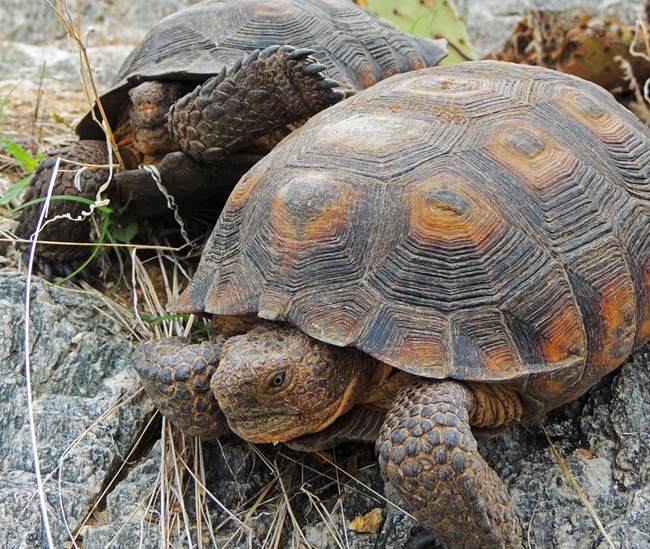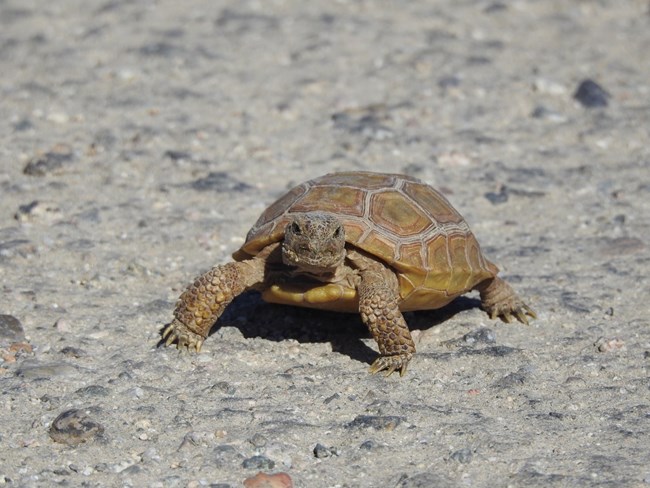Gopherus marafkai
NPS photo Like the saguaro and the Joshua tree, the beautiful desert tortoise has come to symbolize the American desert. Turtles have roamed this earth since before the time of the dinosaurs. It is thought that individual tortoises, inhabiting the same patch of desert season after season, may live for fifty or even one hundred years. For many of us, an encounter with a wild desert tortoise is the thrill of a lifetime. Almost everyone loves tortoises, and many people keep them as pets. Yet there are signs that, as southern Arizona's human population expands, we may be loving tortoises to death. Some populations near urban areas have already disappeared. Natural HistoryDesert tortoises occur in scattered populations throughout the southwestern United States and northwestern Mexico. Unlike aquatic turtles, they are strictly land-dwelling and avoid water except for an occasional drink. Like other reptiles, tortoises cannot control their body temperature internally. They avoid extreme temperatures by retreating to underground burrows and only rarely, when conditions are favorable, do they emerge to drink and feed on grasses, flowers and cactus fruits.

Tortoise ShellsThe female's carapace (upper shell) is flared in the back, perhaps to allow more room for eggs. The male's plastron (bottom shell) is concave to fit over the female's shell while mating, and his carapace has an inward curve at the lower back to facilitate the nearly vertical mating posture. The male uses his longer, more curved gular shield in fights with other males, attempting to knock the rival on his back. (If a tortoise cannot right itself, it will die.) Encountering the Desert TortoiseUnless you were born here or have raised a family in Tucson, chances are that the tortoise you meet at Saguaro National Part has been here longer than you! It knows its home area well—where to go for nutritious spring shoots, summer grasses, or precious water after a summer rain. From many years of experience, it has discovered the best shelters and the most direct routes to them. A tortoise you see crossing a road is probably not lost, but following a path established long before pavement was laid. What Do You Do?What should you do if you encounter a desert tortoise? Unless it is crossing a busy road, the best thing is to leave it alone. However, if a tortoise is in danger of being hit by oncoming traffic, pick it up and gently place it off the road in the direction it was headed. Handling wild tortoises is illegal in Arizona, and for good reason—when a tortoise feels threatened, it may void urine that is distateful to a predator but essential for the the tortoise to survive a prolonged drought. Some people believe that they should move tortoises they find to a national park or some other protected place. Wild tortoises belong where you found them and probably have a better chance of surviving in a familiar residential area than in a new, unfamiliar place. Many also release pet tortoises they can no longer care for. Please don't! Tortoises that have been in captivity rarely have the skills necessary to adapt to a natural area. Releasing pet tortoises into the wild is illegal due to the potential transfer of diseases to wild tortoises. Such introduced diseases are suspected of killing hundreds (perhaps thousands) of desert tortoises in California. 
NPS photo Helping Desert TortoisesThere are many things you can do to help desert tortoises. If you can no longer care for your pet tortoise, the Arizona Sonora Desert Museum - (520) 883-1380 - in Tucson and the Arizona Game and Fish Department - (602) 942-3000 - in Phoenix have adoption programs for tortoises and will help find it a caring home. If you hear of someone taking a tortoise from the wild, teach them what you know. Perhaps the best way we can assist tortoises is to help save their diminishing habitat by participating in desert preservation efforts. At Saguaro National Park, biologists are actively working with the University of Arizona, the National Biological Service and the Arizona Sonora Desert Museum to learn more about the desert tortoise. Studies in the park include population surveys and monitoring, dietary studies and determining the effects of wildland fires on tortoises. We have much to learn about what is most important to these ancient and fascinating animals. Our goal is to ensure that our desert tortoises will find a good home here for many, many years to come. Which Tortoise is it?Here at Saguaro National Park, you will encounter the Sonoran Desert Tortoise. This species is now considered separate from the Mojave Desert Tortoise, though the differences in their shells may not be obvious to you. Recent studies indicate that threats to the Mojave tortoise population in California and Nevada warrant protection as a "threatened" species, while the same study found that the Sonoran tortoise occurs in healthy numbers in Arizona. This is encouraging news for wildlife watchers here but is no cause to let up on our efforts to protect habitat for this symbol of desert endurance. |
Last updated: January 2, 2024
